Vittoria Air-Liner Road
Every once in a while a product shows up for a single-sport market that just isn’t going to be immediately adopted by the sportsmen for which the product was intended. It takes the triathlon market to make it popular first, and then it migrates back to the sport for which it was made. I suspect that will be the case here.
Because triathlon is the first market to have its apex users overwhelmingly adopt road tubeless, it is likely to be the first market to adopt road bike foam liners. These are popular in MTB and are becoming more popular in gravel. They allow the use of lower tire pressures without the fear of rim damage. Users report fewer flats. But in the case of Vittoria’s Air-Liner, just introduced, those choosing road tubeless now have a rideable solution if all fails and the tire just won’t hold air.
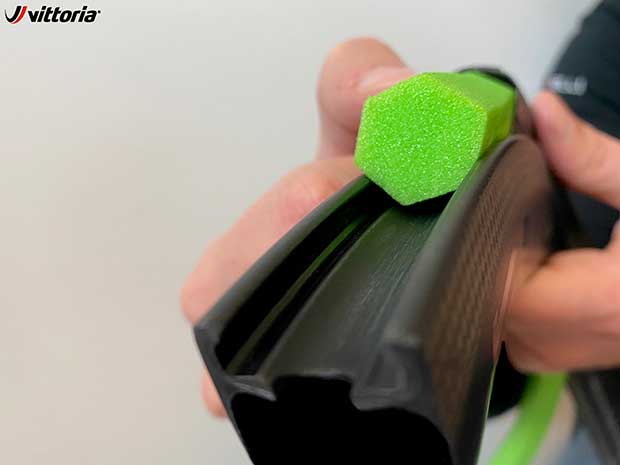
Here is the claim: “In the event of air-loss, the Vittoria Air-Liner Road system is designed for run-flat use, to get you back home.” (Or in our case, to T2.) You don't get that with clincher or tubular tires.
This is potentially a big deal for triathletes, for two reasons. First, for those who are afraid of road tubeless because of what might happen if the tire does go flat – the tire jumping the rim, for example, potentially causing the rider to lose control and crash – the foam liner appears (to me) to keep the tire beaded up onto the rim.
Second, you can ride the flat: up to 50 kilometers according to Vittoria. No, it’s not rideable at the same speed with the same power, but if the pressure loss occurs close enough to the end of the bike leg, don’t stop, just ride it in.
So, although this will be of considerable potential utility to bike racers, the tech is probably of more use yet to triathletes.
You still use sealant in your tires, and these foam liners do not absorb or uptake the sealant. These liners weigh about 25 grams each (a little more for the larger road tires and rims I ride), and that is about half the weight of the sealant. Roughly, a tubeless wheel, with tire, stem, sealant and foam insert should weigh about the same as a typical tubed wheel and tire.
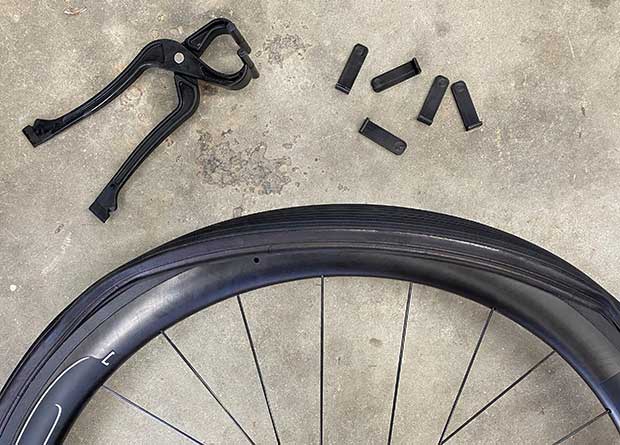
I don’t have miles on this yet, but I did want to obtain a set of these and report on the process of mounting them. An instruction video says to insert the Air-Liner “just like you would do with an innertube.” Well… not quite. The insert is smaller in circumference than the wheel, by a fair bit, so you need to stretch it around the rim like a big, thick rubber band. I mounted the first bead of the tire first, then the Air-Liner, and then commenced mounting the second bead of the tire.
Mounting the second bead is typically a no-tools job for me and when I can’t do it hands-only that’s a sign that either I’ve gone past my own best-on date, or there’s something wrong with the system (the tire is too small, or the rim is too large). In the case of this particular foam insert, I think the volume of the insert keeps the tire’s beads from sitting in the rim well, and that makes the tire impossible to mount hands-only. If you look at the image above, this is about where I got the tire on the rim before things started to get tough.
Vittoria makes a toolkit for the installation of the tire with the Air-Liner installed. I could not quite figure out the technique of the included pliers and clips (also in the image above) and reverted to some pretty beefy tire levers, which got the tire on fine, though with quite a bit more difficulty than would have been the case without the use of the foam insert.
The instruction video I saw (embedded just above) did not include the use of the bead pliers when mounting the rim, but documentation I read says that you can use these pliers both for mounting and dismounting. The video did, however, reinforce that you must use the pliers when dismounting the tire.
When you air up the tire this compresses the foam. There’s a video with an animation of how this works, and I’ve embedded it below. This means that in the course of regular riding the sealant is free to patrol the tire, seeking out and solving any leaks.
You have three size options, even for 700c road, and this depends on the volume inside the tire, which in turn depends not only on the size of the tire but the inner bead width of the rim.
When would you use these? What would these mean to you? Let’s face it, there’s added cost and complexity here. the tookit is $25, and the Air-Liner foam inserts are $39.99 each. This is in addition to what you spend for the tires themselves of course.
The value is this: If you spend $800 to enter an IRONMAN race, and all-in you’re spending $3000 or $5000 to do that race, with travel, hotel and the like; and if this is a race in which the training time you’ve invested is worth far more than the money just quoted; it’s heartbreaking to have to DNF, or finish well behind your ambition, because of a flat. Therefore, it seems to me this is a small cost if what you get is both a lesser chance for a flat, and a rideable solution if you flat.

On the other hand, I cannot envision placing a new tube in a tire in the field if you flat, as you would a standard clincher. If you flat with this system, you can ride it in, or you can abandon. Beyond that, there is the complexity of the install. Offsetting that are the rave reviews I get from gravel riders on their foam inserts, and they don’t seem to have a problem with the install.
I don’t know how long they last. Probably longer than a tire. And, foam inserts don’t flat. They’re like the midsoles of your running shoes. In fact, very much like them. Same material, though at a much lower density.
I could imagine the biggest headache being the periodic changing of sealant. If one assumes that the tire should be dismounted, rim and tire cleaned of sealant, and sealant replaced every 6 months or so, then you’d have to wipe the sealant off the foam insert and then get about the reinstall.
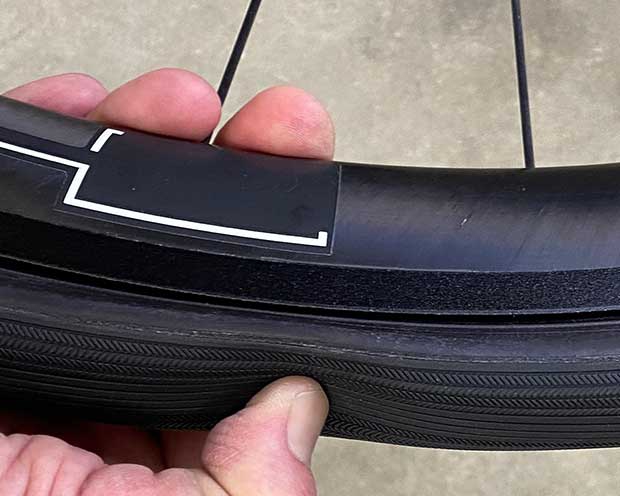
I’ll be riding these around, playing with them, installing and uninstalling, and provide a long term review. I see no reason not to use them. But if you look at the image above, this is me pressing my thumb against the tire when all the air is let out. So, don’t be fooled. Yes, it’s a rideable solution, but you’re not riding on that little spare space saver tire that comes in your sedan. You’re basically riding a rideable flat tire. This is how you’re getting home in case of a complete blowout. But it’s certainly better than the alternative.
Here’s more about the Vittoria Air-Liner Road. Note that you’ll see in one of the videos above a kit that includes 2 x foam liners, the toolkit, sealant, Vittoria's valve stems which it says are key to the optimal use of this tech, everything you need, sort of like the starter kit you get with your first razor from Harry's. I don’t see these kits yet for sale in the U.S., but I'm assured they'll be available and probably by the time you read this. The kit will sell for $99, which is a nice deal.



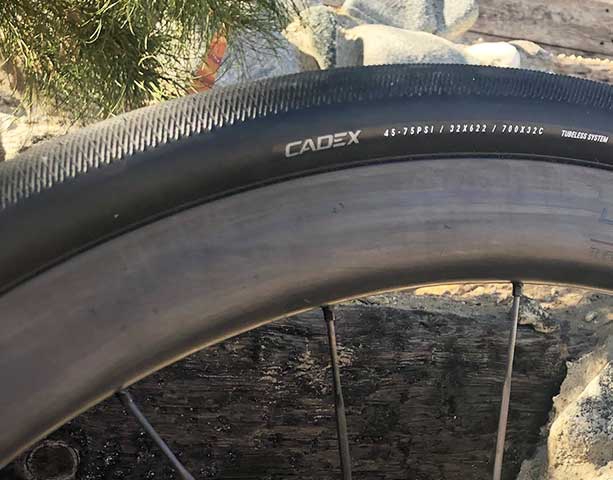
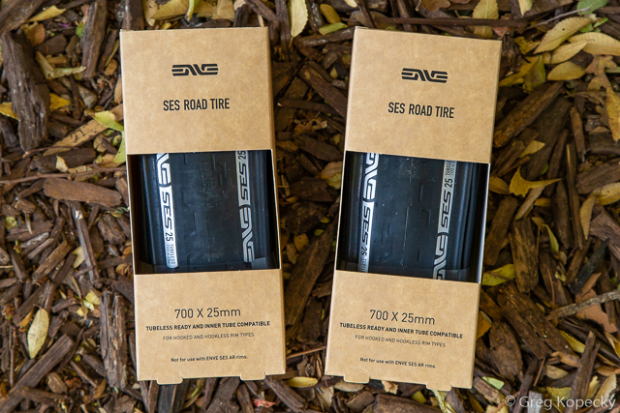
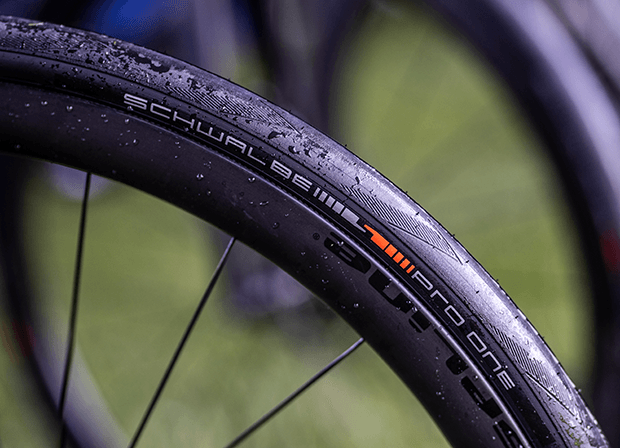

Start the discussion at forum.slowtwitch.com